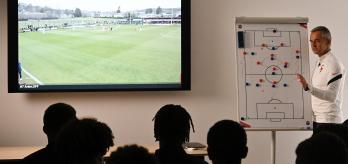Introduction
The session is divided into three parts: 1) in possession ; 2) out of possession; and 3) attacking set pieces (corners and throw‑ins). In his analysis of each of these areas, Vannuchi underscores what the players did well during the game, before highlighting scenarios that they could have handled better and which they will work on during Thursday’s session.
The overall assessment of the game is that France produced a strong performance, particularly during the first half, in which the team dominated possession. In the attacking phase, the Bleuets carved out nine chances, but only managed to convert two of them. The players’ exertions in the opening 45 minutes took their toll after the break, with the team’s fitness and technical levels dropping notably, resulting in a high number of turnovers.
Part 1 – in possession
Positives:
-
Good use of the flanks, with examples showing the wingers tucking inside to free up space out wide, or the wide players finding space in behind the Wales rearguard, as well as overlapping runs which see the full‑back link up with the winger.
-
Counter‑switching (shifting back to the side where the move initiated) was carried out relatively successfully. However, Vannuchi reiterates the importance of making infield runs as a decoy in order to make space for a team‑mate by forcing the opposition full‑back infield.
-
Vannuchi also points out the high number of players who get into the box, ready to get on the end of crosses and create danger in and around the Wales goal.
Areas for improvement:
-
During certain phases of play, the off‑the‑ball movement could have been better if the players had taken stock of their surroundings and adapted their runs based on their team‑mates’ positioning. Generally speaking, the player who can see the ball and his team‑mates has to base his movement on the others, as they are unable to see the full picture.
-
When play is developing high up the pitch, centre-backs must make sure that they keep tabs on the opposition centre‑forward so that they can quickly intervene or close down the space available to the centre-forward should the ball be turned over.
Part 2 – out of possession
Positives:
-
The pressing by the four attacking players (centre‑forward, wingers and attacking midfielder) was well synchronised and effective. The centre‑forward initiated the press by closing down the centre‑back on the ball and looked to force play down one side. If the ball was played wide to the full-back, the winger closed down the full‑back and the centre-forward tried to cut off the pass to the ball-far central defender while the attacking midfielder marked Wales’s holding midfielder. As worked on during the week, if Wales managed to switch play the winger on the opposite flank was ready to jump out and put pressure on the second centre‑back to help force a turnover.
-
The France players put in a huge effort during defensive transitions and were rewarded for this by registering a high number of ball recoveries.
Areas for improvement:
-
In certain pressing phases, France occasionally struggled to shift across in time with the ball while remaining in a compact block to limit the space. Vannuchi shows the players some examples where the wide players failed to make the right decision because they hesitated over which player they should close down. These clips also highlight that the defensive line has to be quicker to respond to switches of play and shift across to cover the Wales winger who is left unmarked when the full‑back steps out to close down his opposite number. In the central zone, the midfielders have to be wary of their counterparts rotating positions and drifting into space to ensure that no opposition midfielders are left unmarked. In certain situations, when the tempo of the game is too fast for the players to communicate among themselves, the France midfielders need to switch to individual marking and track their player closely.
-
Vannuchi once again stresses the importance that the centre‑backs stay close together and within pressing distance of the opposition centre‑forward so that they can close him down in the event of a turnover.
Part 3 – attacking set pieces
Positives:
-
Two good corners led to goalscoring opportunities. One was taken short and the other was sent straight into the box. Vannuchi underscores the importance of a good delivery to create dangerous openings. Corners that are played straight into the box are generally more dangerous when they are outswinging and land between the penalty spot and the six‑yard box.
-
In terms of the team's ability to maintain possession from throw-ins, Vannuchi also highlights two switches of play following a throw-in, which allow the team to escape the opposition press and exploit the space on the other side of the pitch.























.variant64x64.jpeg)




.variant348x164.jpeg)


